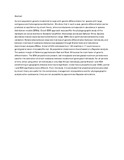Phylogeography in continuous space: coupling species distribution models and circuit theory to assess the effect of contiguous migration at different climatic periods on genetic differentiation in Busseola fusca (Lepidoptera: Noctuidae)

View/
Date
2014Author
Silvain, J-F
Calatayud, P-A
Ong'amo, G
Sezonlin, M
Campagne, P
Gigot, G
Faure, N
Branca, A
le Ru, B
Dupas, S
Type
ArticleLanguage
enMetadata
Show full item recordAbstract
Current population genetic models fail to cope with genetic differentiation for species with large, contiguous and heterogeneous distribution. We show that in such a case, genetic differentiation can be predicted at equilibrium by circuit theory, where conductance corresponds to abundance in species distribution models (SDMs). Circuit-SDM approach was used for the phylogeographic study of the lepidopteran cereal stemborer Busseola fuscaFüller (Noctuidae) across sub-Saharan Africa. Species abundance was surveyed across its distribution range. SDMs were optimized and selected by cross-validation. Relationship between observed matrices of genetic differentiation between individuals, and between matrices of resistance distance was assessed through Mantel tests and redundancy discriminant analyses (RDAs). A total of 628 individuals from 130 localities in 17 countries were genotyped at seven microsatellite loci. Six population clusters were found based on a Bayesian analysis. The eastern margin of Dahomey gap between East and West Africa was the main factor of genetic differentiation. The SDM projections at present, last interglacial and last glacial maximum periods were used for the estimation of circuit resistance between locations of genotyped individuals. For all periods of time, when using either all individuals or only East African individuals, partial Mantel r and RDA conditioning on geographic distance were found significant. Under future projections (year 2080), partial r and RDA significance were different. From this study, it is concluded that analytical solutions provided by circuit theory are useful for the evolutionary management of populations and for phylogeographic analysis when coalescence times are not accessible by approximate Bayesian simulations.
Citation
Dupas, S., et al. "Phylogeography in continuous space: coupling species distribution models and circuit theory to assess the effect of contiguous migration at different climatic periods on genetic differentiation in Busseola fusca (Lepidoptera: Noctuidae)." Molecular ecology 23.9 (2014): 2313-2325.Publisher
University Of Nairobi
